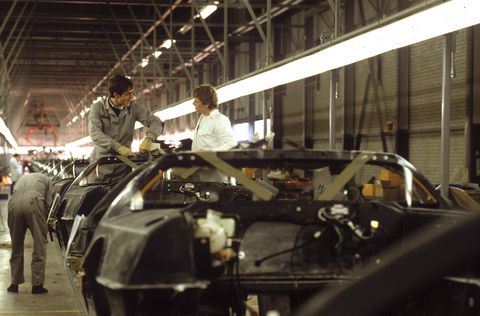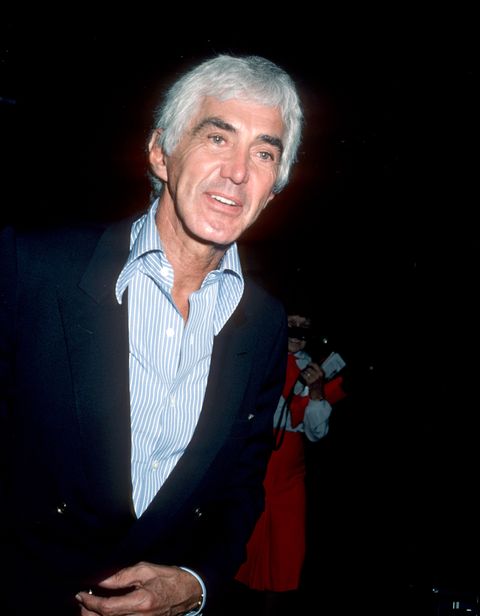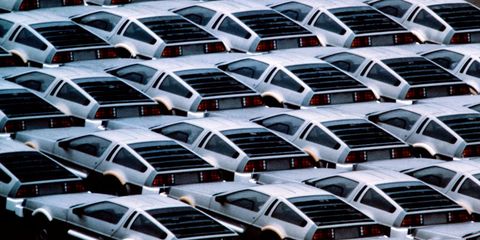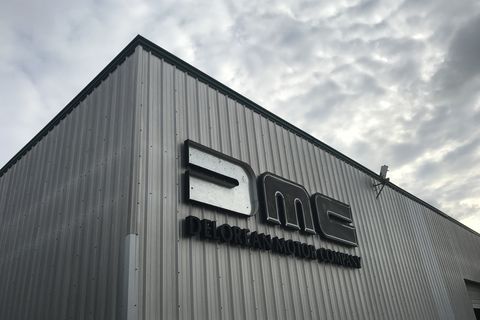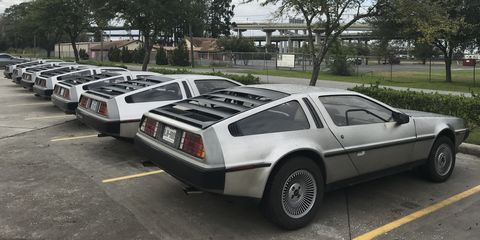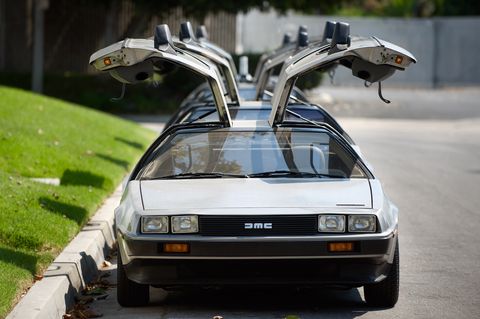
The speedometer climbs as we race down a straightaway in Humble, Texas. As the needle edges to 60, 70, then 80 miles per hour, the 36-year-old automobile rattles and the wind whistles through the windows. Finally the DeLorean zooms up to 88 miles per hour and we feel, just for a moment, like we’ve gone back to the future.
Then, a series of loud honks from the other side of the road, followed by animated waving, awaken us out of our speed spell. “We get that all the time,” says DeLorean Motor Company CEO Stephen Wynne, sitting shotgun. “That doesn’t happen with any other car.”
After our speed reverie, we pull back into DMC’s Texas headquarters, located in this Houston suburb. It’s a wet November day and DeLoreans line the parking lot. “It’s the only lot in the country where you see this many DeLoreans at any given time,” Wynne says.
The open garage door reveals cars in different stages of repair, some exposing their rear engine and others with their gullwing doors open, steel birds ready to take flight. In all, three dozen DeLoreans are scattered in and out of Wynne’s DMC headquarters, all in the midst of being repaired and restored to their former glory.
The DeLorean DMC-12 is more than a movie prop or simple automobile; it’s a long, strange legacy wrapped in stainless steel. That legacy, buoyed by the ongoing love for the Back to the Future films, keeps the car in the public imagination, and gave Wynne the ammunition to pursue a plan that’s much more ambitious than simply getting a 36-year-old car back on the road. He wants to build a brand new DeLorean, one created in the present using the road map of the past.
“I’m fiercely proud of DeLorean, but the car they put out could have been better,” says Wynne. “We’ve had 30-plus years of [research and development] and 9,000 prototypes that were made, all so I can make 300 really nice cars a year.”
Crash and Burn
The infamous story of DeLorean Motor Company starts with John Z. DeLorean, the founder and company’s namesake. In the late ’70s, DeLorean departs GM at the height of his powers to build “the new American sports car.” He gets $200 million in investment and production begins in 1981 in Belfast on the sleek, stainless-steel, gullwing DMC-12.
Cost overruns forces DeLorean to rush the car to market and sell it for more than double the initial asking price, which, along with concerned reviews,leads to selling only half of what he hoped. In February 1982, the company basically declares bankruptcy and DeLorean himself runs into legal trouble. What was once such a promising venture, DeLorean—the company, the car, and the man—hit rock bottom.
It wouldn’t be until three years later, when Doc Brown opens his conspicuous trailer at Twin Pines Mall, that the futuristic-looking automobile speeds off at 88 miles per hour and becomes a pop culture icon. But today’s DeLorean Motor Company, revived from the remains of the original with its founder’s blessing, has a much different story—and it starts with Wynne.
In 1980, Wynne, a Liverpool native, moved to the U.S., and after a stint on the East Coast, he went west to California where he opened a repair shop, exclusively working on English and French car brands like Lotus, Jaguar, Renault, and Peugeot.
But Wynne saw opportunity in DeLorean’s meteoric rise and fall. “Nobody wanted to work on DeLoreans, nobody knew how to work on the DeLoreans, and nobody was interested in learning how to work on DeLoreans,” says Wynne. Except for him. Wynne had a wealth of experience working on similar cars—after all, DeLorean’s preproduction and development was primarily done by Lotus, while the car’s engine and transmission were made by Renault. “It was basically a mix of the English and the French,” says Wynne. “Everything about the [car] was what I already knew.”
By 1983, the year after production of the DMC-12 had ceased, Wynne quit everything else and was working exclusively on DeLoreans. “When you have very little competition, you can do things the way you want,” says Wynne. He knew it was going to be a tremendous challenge. “Compared to what was around, it was an incredible-looking car,” says Wynne. “But…there was no factory support and I was going to have to figure everything out. It was part business, part ego.”
By the mid-1990s, he went fully in on the car when he began acquiring the trademarks and IP around the name “DeLorean Motor Company.”
Putting the Parts Together
In his Belfast factory in Northern Ireland, DeLorean had stockpiled enough parts to build nearly 30,000 cars, but only ended up producing about 9,200. In November 1982, a company called Consolidated International bought DMC’s U.S. assets, including thousands of leftover parts, and stored them in a facility in Columbus, Ohio.
“It was a huge, huge inventory,” says Wynne. “It was stored in this [four-story] building that was built in the early 1900s and each story was 80,000 square feet.”
Wynne was buying parts from them all the time for his burgeoning DeLorean service business. Then in 1997, a decade and a half after DeLorean went bust, Wynne took a gamble. “I don’t know whether I was the only sucker or what, but I was able to put a deal together to acquire all the inventory,” says Wynne.
To accommodate his new stash of car parts, he built a warehouse and restoration center in Humble, Texas. It took 85 semitruck loads to move the parts the 1,100 miles from Columbus, Ohio, to the Houston suburb.
Right now, most of DMC headquarters is garage work space and storage for these 37-year-old car parts. There are meticulously ordered giant racks holding thousands of original DeLorean components. There are gullwing doors by the dozen, hubcaps by the hundreds, and bolts by the thousands. There are also windshields, headlights, cooling fans, seat belts, side panels, floor mats, and every other piece that together composes a DeLorean.
“There’s 2,650 parts that go into a DeLorean…and we have all the parts right here,” says Wynne. As we pass by stacks of engines, with only 70 of those remaining in the stockpile, he says, “I’m very cautious on how I sell them. I don’t waste engines.”
We pass by rows of tires, which Wynne says they rarely use. “These are [37-]year-old tires. They are originals and met standards then, but now…dry rot.” Currently, these parts are sold to fellow DeLorean owners or used in the more than a hundred in-house restorations done every year across their four facilities in Texas, California, Florida, and Illinois. Those restorations cost on average $20,000 to $50,000, depending on the condition of the original.
Car parts aren’t the only thing Wynne he purchased after the fall of the DeLorean empire. He also got the entire archives, marketing files, and the original racks, crates, and boxes that the parts were stored and shipped in.
“Look at this,” says Wynne, pointing to a sticker on a box of louvres, “this is from the company in Augsburg, West Germany. West Germany doesn’t even exist anymore. We don’t throw these boxes away. They are way too cool.”
But perhaps the most valuable thing Wynne obtained in the sale were the original specs, supplier drawings, and blueprints of all 2,650 parts in a DeLorean. In other words, he’s got John Z. DeLorean’s brain on file.
“This is gold for us. We have notes on every part,” says Wynne. “So, although some of the suppliers are gone now, we can go out and get stuff reproduced…you can only do so many restorations and sell so many parts over the counter. The next thing to do is start making cars.”
When FAST Means Slow
In December 2015, Congress passed the FAST Act, which included a provision allowing for “low-volume manufacturers” to produce up to 325 turnkey replica cars a year that would not need to be subjected to today’s safety and production standards and could be built conforming to the production year’s requirements.
For a DeLorean, that’s 1981 at a time, for example, when airbags were not yet required. This was a massive victory for those wanting to own their replica Cobra, Morgan, or even 1955 Corvette. It was also a huge deal to builders like Wynne. The company immediately made plans to go back into production on the iconic automobile, looking to bring in ex-Lotus staff to help reengineer the car (just like the original) and swapping out the original 130-horsepower engine with a new, modern 300- to 400-horsepower one.
They had enough original parts to build 350 to 400 cars. For missing parts, they had all the schematics and drawings to reproduce new ones. It was a nearly ideal situation. In the fall of 2016, DeLorean started accepting applications “from those with an interest in being placed on a reservation list” to purchase a car. “It was a pre-intent to intent to maybe buy a car,” chuckles Wynne. The list, according to Wynne, is now up to 5,000 people. Everyone was excited for a brand-new replica DeLorean.
Except there was one problem.
Buried in the act, the provision says that the Department of Transportation, more specifically the National Highway Traffic Safety Administration (NHTSA), has 12 months to issue specific regulations and processes around how the low-volume manufacturers go about making these replicas. Three years later, this still hasn’t happened yet and it’s a source of extreme frustration.
“They basically need to approve a one-page document with a bunch of checkboxes on it. It’s like, ‘Come on.’” He doesn’t know the reasons for the holdup, but speculates it’s due to change of administration in 2016 and that it took a while for NHTSA to get a chief counseland a director. And, of course, there’s now the weeks-long government shutdown.
While, in theory, DeLorean could go ahead and build cars anyway, they would only be able to be sold in Europe and Asia—not in the United States. “An American car from an American brand that can’t be sold in America,” says Wynne. “It’s horrible.”
Wynne isn’t alone. The Specialty Equipment Market Association (SEMA), of which DeLorean is a part of, is so upset by the missed deadline that they are threatening to sue. In a November press release, SEMA said the lengthy lack of action is hurting small businesses, consumers, and workers, and they were preparing to “challenge the agency in court if it fails to take immediate action to implement.”
When contacted about any further updates, SEMA wrote in a statement to Popular Mechanics that a lawsuit is “prepared but not yet filed…SEMA is in direct communications with the agency and believes publication of a proposed rule is imminent, to be followed by a final rule at some point in 2019.”
When contacted, NHTSA responded via email: “At this time, due to shutdown, the agency cannot assist on this matter.”
This has put Wynne’s ambitious plans on hold for the moment, but not canceled. There’s optimism that this will be figured out early this year, and Wynne is moving forward in converting a large chunk of DMC’s storage space into an automobile assembly hall.
They’ve also set a modest plan of only producing 22 cars in the first year, whenever that is, before climbing to 50 in the second and, then, 100 in the third to see “how that fits” (which means, with enough original parts to build 400 cars, original parts should last at least to year five). He says that they can’t set a price yet on one of these new replicas due to not knowing the exact materials that will be needed, but believes it will cross the $100,000 threshold.
Beyond these initial steps, though, Wynne is still waiting.
“It’s an awful a lot of money. If we spend it and, the day we’re finished, we can’t take orders, we will go under.”
A Future Beyond Back to the Future
So, what would the car’s namesake have thought about an English mechanic reviving his iconic car out of a suburban Texas assembly hall? Prior to DeLorean’s death in 2005, Wynne says they had several “nice, causal” phone conversations about a variety of subjects. Even then, Wynne was considering the idea of bringing back the iconic automobile and mentioned it to DeLorean.
“He said he thought it was a really good idea and offered his assistance,” says Wynne. “He was very supportive.”
Wynne thinks DeLorean’s downfall was primarily tied to having a way too aggressive business plan. “They went from zero to production in 22 months,” says Wynne. “They rushed it.”
But where DeLorean’s main problem was not having enough time, Wynne has too much. “All I want to do is to [put] Deloreans on the road…I’m frustrated we can’t do that yet.”
[“source=popularmechanics”]



